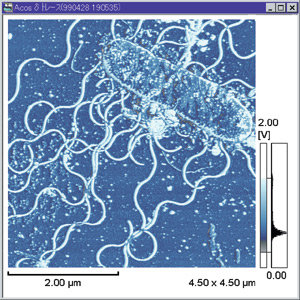Vibrio alginolyticus
Classification
Higher order taxa
Bacteria; Proteobacteria; Gammaproteobacteria; Vibrionales; Vibrionaceae; Vibrio
Species
|
NCBI: Taxonomy |
Vibrio alginolyticus
Description and significance

Organisms from the Vibrio genus were first observed by Filippo Pacini in 1854, and were further described by Robert Koch in 1883. The species V. alginolyticus emerged on the scene as a result of the need to further classify another Vibrio species, Vibrio parahaemolyticus. V. parahaemolyticus historically had included two biotypes, but it was suggested by Zen-Yoji et al. in 1965 the second biotype be moved into its own species. In 1968, Sakazaki et al. proposed a new name for the biotype species: Vibrio alginolyticus. V. alginolyticus would later be isolated in 1997, as a result of a pathogenic outbreak in Russia.5, 7
V. alginolyticus can be “comma” or coccoid shaped and is Gram negative.4 There are a few different strains, many of which are pathogenic. V. alginolyticus displays a single polar flagella in liquid media, but when the bacteria is introduced to solid media, morphogenetic changes occur to produce numerous lateral flagella (see photo).1
(For more information, see: Vibrio).
Genome and genetics
Vibrio organisms belong to the larger prokaryotic branch of Proteobacteria. V. alginolyticus itself is closely related to the Vibrio species of V. cambellii, V. parahaemolyticus, and V. proteolyticus, based on 16S rRNA sequencing.1
The complete genome of V. alginolyticus has been sequenced by Illumina high-throughput sequencing.2 The genome was revealed to have a total size of 5,406,094 bp and G+C content of 44.71%. The genome has 4,644 coding genes present. The complete sequence was deposited at GeneBank under the ascension numbers CP016224 and CP016225.
Nutrition and metabolism
While Vibrio species do vary greatly in their nutrition and growth requirements, one feature shared by all members of this genus is that they are halophilic, requiring the presence of Na+ to grow.1 V. alginolyticus has an absolute salt requirement, meaning it will not grow unless in the presence of salt. For V. alginolyticus the minimal concentration of NaCl required for optimal growth is approximately 200-260mM.1 Most Vibrio species prefer a pH range of 7-8 for optimal growth, at a temperature of 18-22 °C.
Vibrio alginolyticus was originally a biotype of V. parahaemolyticus, due to many similarities, but the differentiating factor was V. alginolyticus' ability to ferment sucrose.6 The bacteria is able to utilize citrate and other sugars as a carbon source, and also can produce extracellular enzymes which degrade DNA, RNA, proteins, lipids, and a variety of carbohydrates.1 V. alginolyticus in particular has been shown to be able to utilize d-glucose, d-maltose, d-trehalose, d-fructose or N-acetyl-d-glucosamine as its sole carbon source.
Ecology / Pathology
Ecology: How is your microorganism important in the ecosystem where it is found? How does it impact other organisms in the environment (could be positive or negative impact)?
Pathology: How does the microbe cause disease as it interacts with the host? Describe any specific toxins or pathways that are used for invading and causing disease in the host. What treatment is used to inhibit or kill the microbe?
Current Research
Describe recent research and findings that have been done with this organism. The research can be clinical, applied or basic research. This section should be based on 2 recent papers (10 years or less) and summarized in your own words.
References
1. Bergey DH. Bergey's Manual of Systematic Bacteriology. Brenner D, Krieg N, Staley J, editors. 2nd ed. New York: Springer; 2005. Vol. 2, part B; pg. 494-546.
2. Deng Y, Chen C, Zhao Z, Huang X, Yang Y, Ding X. Complete Genome Sequence of Vibrio alginolyticus ZJ-T. Genome Announcements. 2016;4(5):e00912-16. doi:10.1128/genomeA.00912-16.
3. Deng Y, Chen C, Zhao Z, Zhao J, Jacq A, Huang X, Yany Y. The RNA Chaperone Hfq Is Involved in Colony Morphology, Nutrient Utilization and Oxidative and Envelope Stress Response in Vibrio alginolyticus. Skurnik M, ed. PLoS ONE. 2016;11(9):e0163689.
4. lbertini MC, Accorsi A, Teodori L, Pierfelici L, Uguccioni F, Rocchi MBL, Burattini S, Citterio B. Use of multiparameter analysis for Vibrio alginolyticus viable but nonculturable state determination. Cytometry. 2006;69A:260–265.
5. Mustapha S, Mustapha EM, Nozha C. Vibrio Alginolyticus: an emerging pathogen of foodborne diseases. Int J Sci Technol. 2013;2(4):302-309.
6. Sakazaki R. Proposal of Vibrio alginolyticus for the biotype 2 of Vibrio parahaemolyticus. Japanese Journal of Medical Science and Biology. 1968;21(5):359–62.
7. Smolikova LM, Lomov LM, Khomenko TV, Murnachev GP, Kudriakova TA, Fetsailova OP, Sanamiants EM, Makedonova LD, Kachkina GV,
Golenishcheva EN. Studies on halophilic vibrios causing a food poisoning outbreak in the city of Vladivostok. Zh Mikrobiol Epidemiol Immunobiol. 2001;6:3-7.
Authored by Parker Morris, a student of CJ Funk at John Brown University
